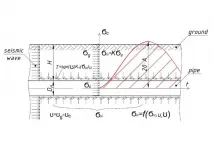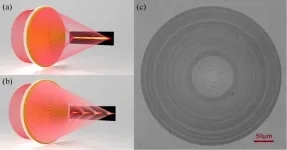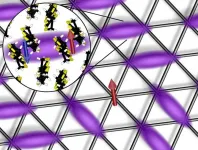(Press-News.org) Two new studies published in Blood suggest that the mRNA COVID-19 vaccine may have reduced efficacy in individuals with chronic lymphocytic leukemia (CLL) and multiple myeloma, two types of blood cancer. According to researchers, these studies could help inform the ideal time for vaccination of these populations.
Study suggests two-dose COVID-19 vaccine is less effective for people with CLL as compared to healthy controls
The first study reports that people with CLL had markedly lower immune response rates to the two-dose mRNA COVID-19 vaccine than healthy individuals of the same age. Because clinical trials of these vaccines did not include patients with blood cancers, who are at high risk of severe illness and complications from the virus, gauging the effectiveness of the vaccine in this population is critically important.
In this study of 167 patients with CLL, only four out of 10 (39.5%) had a positive antibody-mediated response to the vaccine; all healthy adults (controls), by comparison, marshalled an immune response.
Interestingly, the research revealed wide variations in immune response among patients with CLL depending on where they were in their cancer treatment process. For example, patients undergoing active cancer treatment had significantly lower response rates to the vaccine when compared with people who had completed treatment and were in remission, 16% vs 79% respectively. Treatment naïve patients (those whose disease is being watched but not yet treated) had a 55.5% response rate. As well, response to the vaccine was markedly higher in people who completed CLL treatment at least a year before vaccination compared with those who were still in treatment within the last year, 94% vs 50%, respectively.
"Overall, the response rate to the vaccine was significantly less than what we see in the general population, which is most likely attributed to the presence of cancer itself and certain CLL treatments," said lead author of the study Yair Herishanu, MD, associate professor in hematology and head of the CLL service at the Tel Aviv Sourasky Medical Center in Israel. "It would seem that if you are untreated, in what we call 'watch and wait' or do not have active disease, you can gain more benefit from the vaccine. Patients who responded the best were in remission, which makes sense because their immune system had a chance to recover."
Aside from not being on active CLL treatment, younger age, being female, and having normal immunoglobin levels at the time of vaccination independently predicted better response rates to the vaccine. In addition to poorer qualitative antibody responses to the vaccine, patients with CLL also had lower antibody titers, which tells us that, in addition to fewer patients responding to the vaccine, the intensity of the response was also lower, explained Dr. Herishanu.
For the study, researchers included 167 patients with CLL and 53 healthy controls from December 2020 through February 2021. All participants received two doses of BNT162b2 messenger RNA (Pfizer) COVID-19 vaccine 21 days apart; this was the only vaccine used in Israel at the time of the study. Patients were 71 years old on average, and 67% were men. Fifty-eight patients (34.7%) were treatment naïve; 75 (44.9%) were on active therapy; 24 (14.4%) were previously treated and in complete or partial remission; and 10 (6%) were in relapse. Antibody titers were also measured two weeks after the second dose. Patients were followed for a median of 75 days since receiving their first shot, and none had developed COVID-19 infection. There were no significant differences in reported side effects to the vaccine compared to the healthy population.
Researchers also looked at immune response to the vaccine based on which CLL treatment patients received. They found similarly low response rates among patients who were receiving common targeted therapies, including Bruton's tyrosine kinase (BTK) inhibitors (ibrutinib or acalabrutinib) or a combination of venetoclax with anti-CD20 antibodies such as rituximab. Notably, none of the patients who received anti-CD20 antibodies within 12 months of COVID-19 vaccination responded. Because only five patients were on venetoclax monotherapy, Dr. Herishanu said they could not draw any conclusions about the impact on response.
People with CLL and other blood cancers remain at high risk for severe illness and complications with COVID-19 infection, and while response rates are lower than ideal, vaccination against COVID-19 is strongly recommended. The authors suggest that an additional booster dose of the vaccine might be needed for patients with CLL who have completed therapy and previously failed to respond to COVID-19 vaccine, though this would need to be studied.
"Even though response rates were not optimal, patients with CLL should still get the vaccine and, if appropriate, it may be better to do so before CLL treatment starts although the disease itself may affect the response," said Dr. Herishanu. "Equally important is continuing to take precautions - wearing a mask, avoiding crowds, keeping a social distance, and being sure close contacts get vaccinated against COVID-19."
He and his team will continue to follow these patients for 12 months to see how many, if any, develop COVID-19 infection following vaccination. Since this study only assessed antibody response, they also plan to check the cellular immune response to gain a more complete picture of the extent to which patients are protected after vaccination.
The researchers note that the same trends would be expected with the other mRNA vaccine (Moderna).
Similar results in elderly patients with multiple myeloma
In a Blood Letter to the Editor also published online today, researchers report similar findings after the first dose of the same vaccine in elderly patients with multiple myeloma. Evangelos Terpos, MD, PhD, of the National and Kapodistrian University of Athens in Athens, Greece, and colleagues compared outcomes of 48 patients with multiple myeloma and 104 healthy controls at Alexandra Hospital in Athens. The median age of all participants was 83. On day 22 after the first dose of the vaccine but prior to the second dose, antibody titers were measured and the median response was 20.6% neutralizing antibodies for the multiple myeloma population as compared to 32.5% for the healthy controls.
At the time of the first dose, 35 (72.9%) patients were receiving anti-myeloma therapy, four were in remission after prior therapy and did not receive any therapy at the time of vaccination, and nine had smoldering (precancerous) myeloma. Based on their findings, researchers suggest that anti-myeloma therapy seems to negatively affect production of neutralizing antibodies after a single dose, although higher patient numbers are needed to further understand this effect. They also wrote that the administration of a second timely vaccine dose is essential for elderly patients with multiple myeloma to develop an adequate antibody-based response.
For more information about COVID-19 vaccines for people who are immunocompromised, see the American Society of Hematology's Frequently Asked Questions.
INFORMATION:
Underground pipelines that transport oil and gas are very important engineering communications worldwide. Some of these underground communications are built and operated in earthquake-prone areas.
Seismic safety or seismic stability of underground pipelines began to be intensively studied since the 1950s.
Since then, a number of methodologies were proposed for calculating stress received by an underground pipeline during an earthquake. The purpose of these methodologies was to make an accurate prediction on the structural stress received by a pipeline during an earthquake, and thus it would allow to decide ...
A virtual human can be as good as a flesh-and-blood one when it comes to helping people practice new leadership skills. That's the conclusion from new research published in the journal Frontiers in Virtual Reality that evaluated the effectiveness of computer-generated characters in a training scenario compared to real human role-players in a conventional setting.
Practice-based training techniques, including role-playing, are sometimes used to help improve training outcomes. However, these methods can be expensive to implement, and often require specialized knowledge and even professional actors to create realistic training environments. In addition, some ...
The preliminary trial results of a novel radiopharmaceutical for PET imaging of inflammation developed at the University of Turku, Finland, have been published. The compound, which targets the vascular adhesion protein 1 (VAP-1) that regulates inflammatory cell traffic, is the first radiopharmaceutical that has been developed completely in Finland and has advanced to clinical trials. In the study that started with healthy volunteers, the radiopharmaceutical was found to be well tolerated and safe.
The radiopharmaceutical is 68Ga-labelled Siglec-9 peptide.
"The dose of the radiopharmaceutical ...
"It is machination, it is deception," said the Director General of the Berlin Royal Museums in his defence when criticized for buying a fake. Wilhelm Bode did not budge an inch: the sculpture he acquired in 1909 was an as yet unknown production of the great Renaissance master, Leonardo da Vinci. After one hundred years and numerous controversies, a group of scientists led by a CNRS researcher* has just proven him wrong once and for all. The Flora wax bust, conserved at the Bode Museum in Berlin, recently underwent radiocarbon (14C) dating, which provided both a precise date and an incontrovertible result: it was made in the nineteenth century, nearly 300 years after da Vinci's death. As the sculpture was made primarily from spermaceti, ...
The life of almost all animals in the ocean depends on the availability of oxygen, which is dissolved as a gas in seawater. However, the ocean has been continuously losing oxygen for several decades. In the last 50 years, the loss of oxygen accumulates globally to about 2% of the total inventory (regionally sometimes significantly more). The main reason for this is global warming, which leads to a decrease in the solubility of gases and thus also of oxygen, as well as to a slowdown in the ocean circulation and vertical mixing. A new study published today in the scientific journal Nature Communications ...
In a new publication from Opto-Electronic Advances; DOI https://doi.org/10.29026/oea.2021.200031, Researchers led by Professor Baohua Jia at Swinburne University of Technology, Victoria, Australia, Professor Cheng-Wei Qiu at National University of Singapore, Singapore and Professor Tian Lan at Beijing Institute of Technology, Beijing, China considered the generation of super-resolved optical needle and multifocal array using graphene oxide metalenses.
Ultrathin and lightweight, metalenses are becoming increasingly significant for their use in photonic chips, biosensors and micro imaging systems such as smart phone cameras.
Compared to conventional lenses, metalenses can improve the image quality of current cameras, ...
In most living animals, egg cells are vastly larger than sperm cells. In humans, for example, a single egg is 10 million times the volume of a sperm cell.
In a new study, Northwestern University researchers found that competition and natural selection drove this curious size discrepancy.
Using mathematical modeling, the researchers considered a time very early in evolution when primordial species reproduced using external fertilization. In the model, bigger reproductive cells, or gametes, presented a competitive edge because they could hold more nutrients for a potential zygote. Smaller gametes, however, required fewer resources to make, which put less stress on the parent.
"Organisms either needed to produce the biggest gametes with the most provisions ...
When temperatures drop below zero degrees Celsius, water turns to ice. But does everything actually freeze if you just cool it down enough? In the classical picture, matter inherently becomes solid at low temperatures. Quantum mechanics can, however, break this rule. Therefore, helium gas, for example, can become liquid at -270 degrees, but never solid under atmospheric pressure: There is no helium ice.
The same is true for the magnetic properties of materials: at sufficiently low temperatures, the magnetic moments known as 'spins', for example, arrange themselves in such a way that they are oriented opposite/antiparallel to their respective neighbors. One can think of this as arrows pointing alternating up and down along a chain or in a checkerboard pattern. It ...
Snow cover in the Alps has been melting almost three days earlier per decade since the 1960s. This trend is temperature-related and cannot be compensated by heavier snowfall. By the end of the century, snow cover at 2,500 meters could disappear a month earlier than today, as simulations by environmental scientists at the University of Basel demonstrate.
Global warming demands huge adjustments in tourism, hydropower generation and agriculture in alpine areas. But the fauna and flora also have to adapt to rising temperatures. By the end of the century, ...
If you are exposed to silica (quartz) dust at work - e.g. from working with concrete and granite - you have a greater risk of certain types of rheumatic disease. This is shown by results from Aarhus University and Aarhus University Hospital, which have just been published in the International Journal of Epidemiology.
Exposure to silica dust at work, which is the case especially at workplaces within construction and industry, may lead to autoimmune rheumatic diseases. Photo: Unsplash.
Exposure to silica dust at work, which is the case especially at workplaces within construction and industry, may lead to autoimmune rheumatic diseases. Photo: Unsplash.
As the research results from Aarhus University show, exposure to ...







